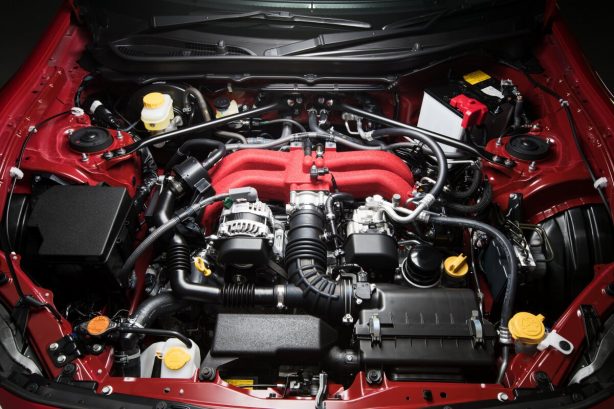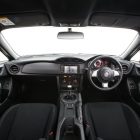Five years after Toyota’s 86 made its acclaimed debut, the popular rear-wheel drive sports coupe has been given a mid-life update that not only brings subtle revision to its styling, but also improved dynamics that will surely resonate with enthusiasts.
Prices have increased marginally across the board, with the biggest increase directed at the entry-level GT manual, which now kicks off at $30,790 – an $800 increase.
The GT auto comes in at $33,090 – up by $600, while our GTS manual test unit starts from $36,490 – an increase of $500. The range-topping GTS auto tops out at $38,790 – just $300 more than the superseded model. All exclusive of on-road costs.
Outside, the ‘new’ 86 can be distinguished by a larger front grille that emphasises the car’s low and wide stance, while those with keen eyes will notice the new “teeth” along the bottom edge of the lower grille, which Toyota says helps smooth airflow. It is flanked by a pair of fog light assemblies that now feature three horizontal strakes. All models now gain reconfigured LED headlights with daytime running lights and LED indicators as standard.
Around the back, the taillights have also been redesigned with LED units, along with a restyled bumper.
Our range-topping GTS features an aluminium wing-type spoiler that enhances aerodynamics and handling stability, while a fresh set of nicer looking 17-inch cast-alloy wheel round up the exterior update.
2017 also brings a more premium look inside the 86, with soft-feel rubber and suede-like materials to lift cabin ambience. Drivers’ hands now rest on the smallest-diameter steering wheel ever fitted to a Toyota – 362mm with a shape that provides optimal grip. The tachometer has been modified so that the 7,000rpm mark – the engine speed where maximum power is achieved – is at the top of the meter.
There’s now a new “track” mode that enables the driver to adjust the level of stability and traction control, including a “fully off” option meant for track use.
What’s been left untouched is the sublime seating position with the lowest hip-point of any production Toyota. Soft kneepads have been built into the door trim and centre console to provide support under high lateral loads (of which there are plenty, as most 86 owners will testify).
It’s a testament to Toyota’s anally retentive attention to detail in almost every facet of their compact sports car.
Not every aspect is a success though. The pedals in our 6-speed manual have been positioned straight on but are spaced too far apart to allow proper execution of heel and toe (at least for my feet anyway).
Nevertheless, choosing the DIY shifter will net you an additional 5kW and 7Nm of torque spread over a 200rpm wider range, from 6,400 to 6,800rpm, compared to the 6-speed auto which retains 147kW at 7,000rpm and 205Nm at 6,400-6,600rpm. Additionally, the manual variant’s final drive ratio as been revised from 4.1:1 to 4.3:1, improving performance slightly.
On paper, the 86 looks decidedly under-nourished compared to similarly priced hot hatches, dispatching its 0-100km/h in 7.5 seconds. The truth is, its performance is more than just numbers. It only takes a couple of corners at moderate speeds to know that you’re in one of the most well sorted cars money can buy. Its balance of feel, communications and enjoyment is a rarity in this price bracket and even beyond.
Its made even better now with a stiffer body structure, particularly at the rear where additional spot welding has been introduced and key components made thicker.
Its coil springs and shock absorbers have been retuned for better handling, stability, ride comfort and turning performance, supported by a thicker rear stabiliser bar.
Unlike most sports cars, the 86 is an entirely amiable companion despite the higher than average cabin noise and rear seats suitable only for legless amigos. Every single input you make results in beautifully measured responses. It rides with controlled comfort at low speeds, thanks in part to its modest 215/45 section tyres and excellent damping. Its steering is fluent, with utterly linear accuracy and superb weighting.
But what impresses most is how the 86 devours corners. Its slick steering, tight chassis control and brilliantly calibrated traction control makes going round bends as addictive as catching Pokémon.
And there’s where the Toyota 86 real brilliance lies. It is at once agile, precise and poised, yet will also indulge its driver with grin-inducing power slides, making every quiet corner a thrill to take.
The 86 isn’t what you’d consider fast, but its pleasing level of performance allows you to enjoy the upper reaches of its dynamic repertoire at speeds that don’t threaten you with demerit points.
Make no mistake though, you’ll have to work the 2.0-litre aluminium horizontally opposed direct-injected engine but you’ll be rewarded with a sharp induction rasp once you pile on the revs, amplified by a sound symposer piped from the intake to the firewall. Its throttle response is crisp and gearshift precise.
And thanks to its as tested kerb weight of 1,258kg, the 86 GTS stops pretty well too.
Fuel economy is also excellent at 8.6L/100km on test, just 0.2L/100km more than Toyota’s claim. This is despite the car being driven hard as well as spending most of its time in stop/start traffic.
Verdict
Design and Comfort: 8.0/10
Performance and Handling: 9.0/10
Quality: 8.5/10
Economy: 8.0/10
Features and Equipment: 8.0/10
A superbly fun and charismatic car in a good-looking and well priced package.
The 86’s back-to-basics rear-wheel drive handling is arguably the purest we’ve seen in a long time. Couple with relatively low running costs and it’s not hard to see why there are so many on the road.
Pros:
- Brilliant handling
- Sleek and accurate steering
- Raspy boxer engine
- Comfortable and driver-focused cabin
- Affordable
Cons:
- Low-rev torque deficit
- Noisy cabin
2017 Toyota 86 GTS pricing and specifications
| Pricing (Excluding on-road costs): | From $$30,790 As tested: $36,490 |
| Warranty: | 3 years/100,000km |
| Warranty Customer Assistance: | N/A |
| Country of Origin: | Japan |
| Service Intervals: | 9 months/15,000km |
| Engine: | 2.0-litre naturally aspirated horizontally opposed, direct-injected 4-cylinder petrol: 152kW @ 7,000rpm, 212Nm @ 6,400-6,800rpm |
| Transmission: | 6-speed manual |
| Drivetrain: | Rear-wheel drive |
| Power-to-weight Ratio (W/kg): | 124.8 |
| 0-100km/h (seconds): | Claimed: 7.5 |
| Combined Fuel Consumption (L/100km): | Claimed: 8.4 / Tested: 8.6 |
| RON Rating: | 98 |
| Fuel Capacity (L): | 50 |
| Safety: | 5-star ANCAP, 7 airbags, ABS, BA, EBD, ESP, Traction Control, Cruise Control, Hill Start Assist, LED headlight, LED DRL, front and rear fog lights, reverse camera, space saver spare |
| Dimensions (L/W/H/W-B) mm: | 4,240/1,775/1,320/2,570 |
| Boot Space (L): | 237 |
| Kerb Weight (kg): | 1,258 |
| Towing Capacity (kg): | N/A |
| Entertainment: | 6.2-inch colour touchscreen with satellite navigation, 6-speakers, Bluetooth, USB, AUX amd CD Player |
Competitors: Subaru BRZ, Hyundai Veloster, Abarth 595, Fiat 124 Spider, Mazda MX-5, Ford Fiesta, Renaultsport Clio R.S. 200
 ForceGT.com Car News, Car Reviews, Video Reviews, Tuning and much more.
ForceGT.com Car News, Car Reviews, Video Reviews, Tuning and much more. 























